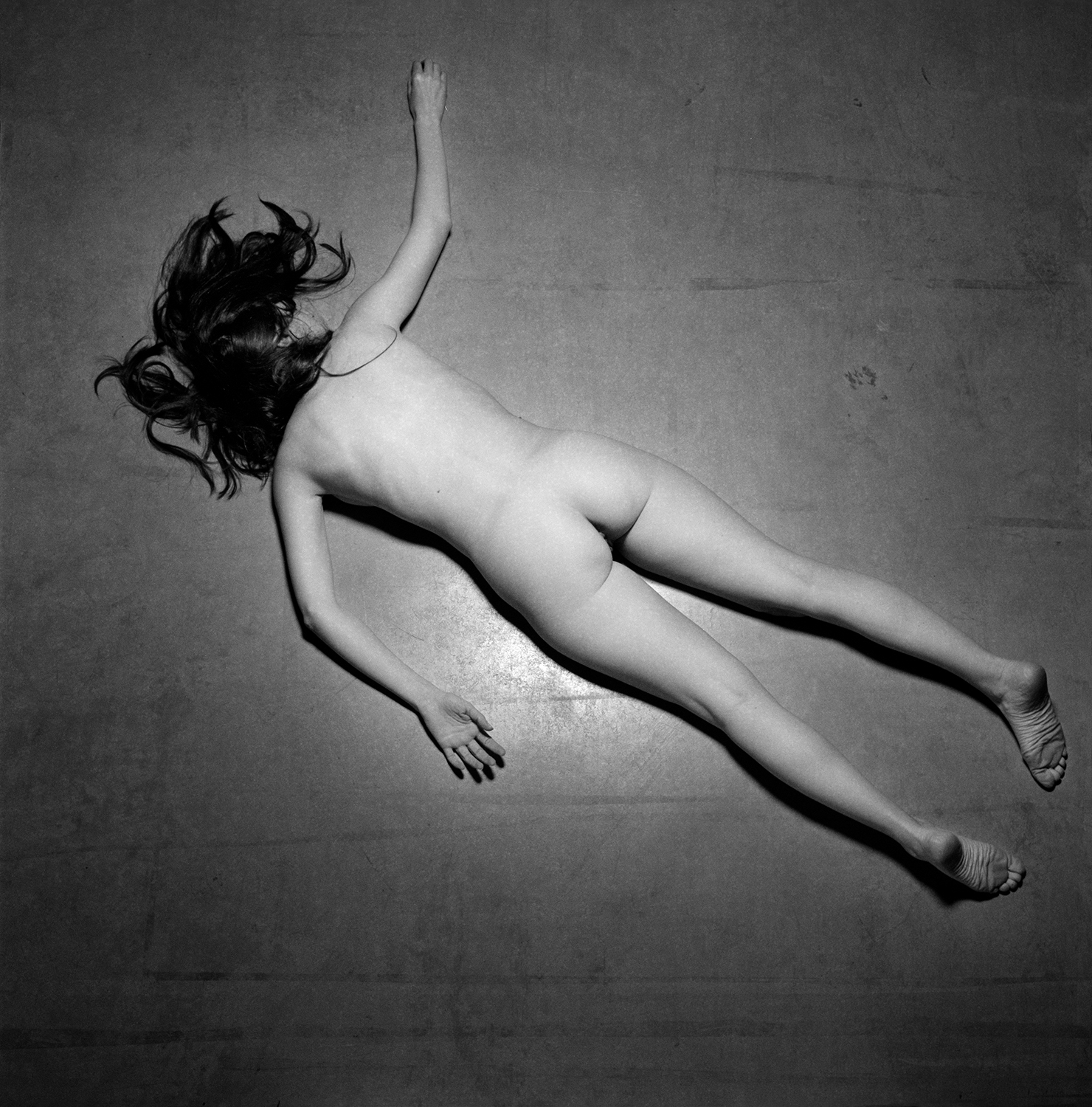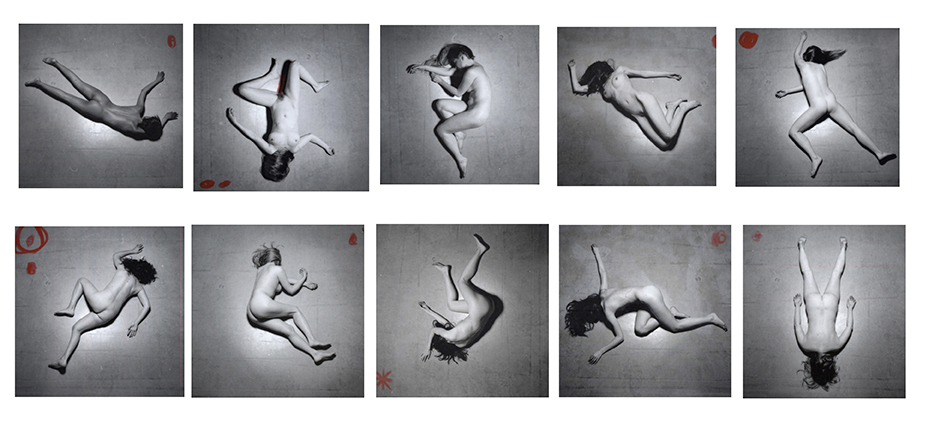THE FALL . CRASH YOURSELF AS YOU ARE Milano, 2016 print on Hahnemuhle FineArt Baryta 40x40 cm n°1/VI
Inclusa dentro lo spazio post-modernista, la sequenza di immagini di Laura Majolino porta immediatamente alla luce il segno di un riferimento: quello del noir, la plongée filmica del momento in cui si è consumato un dramma. Non la sagoma di un cadavere, ma il momento dell’incontro con la non-vita.
La luce è sul corpo nell’istante in cui la vita si disarticola e il corpo perde la sua grazia, la sua identità personale.
E’ lo scatto ultimo di quel frammento temporale fra il nulla e la vita animata. Una testimonianza, l’ultima memoria del corpo e del suo concretizzarsi in una forma.
Il riferimento al palcoscenico – evidenziato dallo spotlight centrale sui corpi – e alla messa in scena di un evento tanto drammatico quanto spettacolare, riproduce nella sua replicazione in sequenza, una mise en abyme dove non c’è e non può esserci soluzione se non uscendo dall’immagine stessa e mettendosi dalla parte del fotografo che architetta e orchestra la scena.
È proprio l’atto di rappresentazione che conduce la fotografia di Majolino su un territorio concettuale della fotografia contemporanea connotata dalla lunga preparazione progettuale per la realizzazione di queste immagini dall’intento impersonale. Stessa inquadratura, stesso sfondo, stessa luce su corpi diversi ma comunque tutte di giovani donne.
Il lavoro dell’artista si distende proprio sul registro narrativo dell’impersonalità e della testimonianza di un evento fortuito seppur con quel riferimento simbolico al filmico. Stessa scena ma posizioni diverse, attori diversi.
Il corpo nudo sotto il riflettore, perde qui armonia, viene privato di ogni sessualità conducendo in un abisso di resistenza l’osservatore e inducendolo a sua volta verso la necessità di indagare l’indagabile, la perdita della vita nella sua rappresentazione meno romantica e più cruda/crudele: l’impatto violento con il suolo.
L’elemento di intimità con il corpo nudo si perde rimane l’impassibilità dell’immagine e l’impossibilità di accedervi. Lo sguardo asettico segue l’anonimato delle figure che neppure hanno volto come se nell’urto con la morte, l’identità si perdesse e fosse soltanto il corpo a recuperare la personalità attraverso un diverso modo di abbandonarsi al suolo.
Un modo diverso di cedere, perdersi e affidarsi alla terra esattamente come la diversa reazione che contraddistingue l’incontro con l’obiettivo del fotografo. Una perdita di senso dunque e un recupero di personalità che ha il duplice scopo di verifica dell’oggettualità della fotografia e dell’uniformità della condizione umana per poi falsificarne il senso se si pensa alla messa in scena, all’occhio del fotografo e alla differenza dei corpi, delle posizioni, degli attributi fisici. L’impersonalità dello sfondo e la ripetizione dell’inquadratura esaltano le differenze sperimentando la conoscenza ultima della singola vita umana. Solo il corpo nudo, spogliato dalle singolarità del costume è in grado, nel momento in cui si lascia, di recuperare una verità e una identità propria permettendo di andare al di là del segno, di una sagoma o di una singola forma grafica.
testo di Charlotte Garlaschelli
THE FALL CRASH YOURSELF AS YOU ARE
Included inside the postmodernist space, the sequence of images by Laura Majolino immediately reveals the mark left by a reference: film noir and the immersive moment of a drama unfolding. Not the contours of a corpse, but the moment when non-life is encountered.
A light is shone on the body in the instant when life unravels and the body loses its grace and personal identity.
It is the final tick in the fragment of time between nothing and animate life. A testimony, the final memory of the body and its materialisation in a shape.
The reference to the stage – highlighted by the central spotlight shining on the bodies – and to the staging of an event that is as dramatic as it is spectacular, reproduces a mise en abyme in its sequential replication for which there is no solution, nor could there ever be one, unless by leaving the image and taking over the perspective of the photographer who is the architect and orchestrator of the scene.
It is the very act of representation that leads the photography of Majolino into the conceptual territory of contemporary photography, characterised by the long preparatory design process involved in the realisation of these images of impersonal intent. The same framing, the same background and the same light on different bodies, but all belonging to young women.
The work of the artist extends over the narrative register of impersonality and bearing testimony to a fortuitous event, notwithstanding the symbolic reference to the filmic. The same scene but different positions, different actors.
The naked body under the spotlight loses its harmony here. Deprived of every form of sexuality, it leads the viewer into an abyss of resistance and induces them, in turn, to satisfy the need to investigate the investigable, the loss of life in its least romantic and rawest/cruelest representation: violent impact with the ground.
The element of intimacy with the naked body is lost. What remains is the imperturbability of the image and the impossibility of gaining access to it. The sterile gaze follows the anonymity of the figures who lack even faces, as if in the impact with death, the identity is lost and the personality is recovered only by the body, through different ways of surrendering to the ground.
A different way to give up, get lost and place one’s trust in the earth, precisely like the different reaction that distinguishes the encounter with the camera lens. A loss of sense, therefore, and a recovery of personality that has the dual aim of verifying the objectiveness of the photography and the uniformity of the human condition, only to then falsify its sense if we think of the mise-en-scene, of the photographer’s eye and of the differences between bodies, positions and physical attributes. The impersonality of the background and the repetition of the framing enhance the differences, gaining ultimate awareness of individual human lives. Only the naked body, stripped of the singularities of costume, is able, in the moment of parting, to recover its own truth and identity, making it possible to go beyond the sign, a contour or one particular graphical shape.
text by Charlotte Garlaschelli










